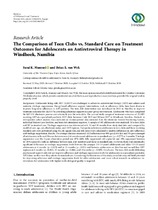The comparison of teen clubs vs. standard care on treatment outcomes for adolescents on antiretroviral therapy in Windhoek, Namibia
Abstract
Adolescents living with HIV (ALHIV) are challenged to adhere to antiretroviral therapy (ART) and achieve and maintain virologic suppression. Group-based adherence support interventions, such as adherence clubs, have been shown to improve long-term adherence in ART patients. The teen club intervention was introduced in 2010 in Namibia to improve treatment outcomes for ALHIV by providing adherence support in a peer-group environment. Adolescents who have completed the full HIV disclosure process can voluntarily join the teen clubs. The current study compared treatment outcomes of ALHIV receiving ART at a specialized paediatric HIV clinic between 1 July 2015 and 30 June 2017 in Windhoek, Namibia. Methods. A retrospective cohort analysis was conducted on routine patient data extracted from the electronic Patient Monitoring System, individual Patient Care Booklets, and teen club attendance registers. A sample of 385 adolescents were analysed: 78 in teen clubs and 307 in standard care. Virologic suppression was determined at 6, 12, and 18 months from study start date, and compared by model of care, age, sex, disclosure status, and ART regimen. Comparisons between adolescents in teen clubs and those receiving standard care were performed using the chi-square test, and risk ratios were calculated to analyze differences in ART adherence and virologic suppression.

